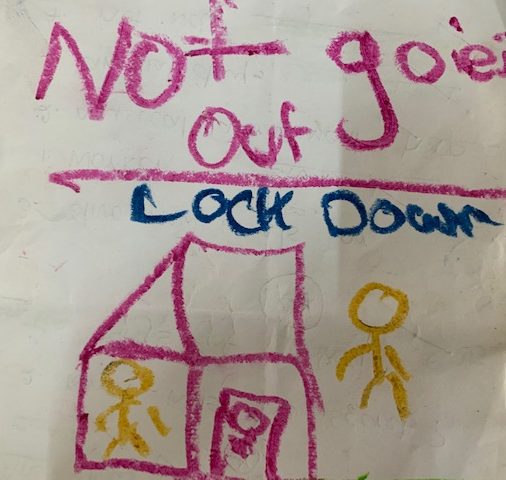I was locked down for over six weeks in a home with no children. As I looked out onto the road, I would see a man on a bike, a woman on a bike, an occasional car driven by a woman or more often a man,but I never saw a child. I was beginning to miss the presence of children that gives me purpose, hope, and always delight. I thought of the story of the Pied Piper of Hamlyn, and what the town must have experienced when almost every child crossed through the tunnel that separated Hamlyn from the ‘other’ world.
So, when Goa announced itself Green and relaxed access to work spaces I was at the library in a heart beat. I met some parents and even some grandparents who came in to trade books, seek recommendations and browse but there were no children yet in sight. We took a call to open our community libraries for lending and book return and I signed up immediately to be present at one site twice a week. I needed the children and I knew in the small community spaces we operate, they would come.
Come they did. The joy was great on my part and I began to plan story, conversation and literacy activities that would – permit me to re-enter their worlds since the lockdown.
School bandh was the first joyful cry – a stark reality for many children for whom school has not yet become a go-to place . Tuition bhi bandh was cheerfully shared. Exams cancelled . Pass ho gaya. Goa green zone. Train passes nahi hai… snippets of this kind were floating around our library room. I began to realise that the children’s vocabulary was all about the lockdown and it intrigued me to think of what words they have acquired in this critical time.
Words ( vocabulary) are one of the building blocks in our language and literacy pathway and I am often looking for entry points and scaffolding to support the children’s language learning in English.
In her seminal work, Teacher Sylvia Ashton Warner introduces the Organic Reading approach which draws heavily on the key vocabulary from a child as a basis of learning to write and read. The organic vocabulary emerges out of the ‘inner mind’ of the child. She says, “children and even adults will learn about things that terrify them.” The lockdown imposed on our lives was a terrifying time and it therefore seemed like a good opportunity for me to think about building on the children’s organic words at this time amongst other things.
Safina, who is emerging as a reader, was so excited to share that she not only knows a word from this time but she can also spell it ! And there before my eyes in orange coloured crayon she writes LOCKDOWN. “ Dekho miss !”, she says. And I do see because the success of writing down an eight letter word and knowing what it means from experience is special for this reader.
Some of the other children, gave us words like vaccine , which fascinated them to see it had two Cs in the spelling and no S. Mask, sanitiser, die, wash hands, hand wash, China, doctor, bandh, hospital, oxygen, Police, Wuhan, virus, safe , sardhi, bukhar, helmet, HANTA virus, no work, distance, social distance, quarantine, thukna, old- people- miss- like -you, spilled out organically but the favourite was “corona”. It did not help that one of the children remembered I use a last name of Noronha, so we had some fun with the phonology of that one. I then suggested we talk a bit about the Coronavirus before we read a book on the topic. The comment , book bhi aa gaye delighted my library heart.
I asked the children to share what they have been doing since the lockdown and I was excited to hear of a summer childhood reclaimed. “Playing miss – whole day playing !” -Games like ghar – ghar , teacher – teacher, chuppa – chuppi, langdi, seven tiles, ring, doctor – doctor where almost everyone dies of Coronavirus , catching cook also called running and some other versions of simply chasing each other until it was time to go inside. The distancing that children were experiencing was not clinically isolating and that reassured me.
Children are learning more about the world and enriching their vocabulary, they are playing games that enrich their bodies and minds and they now have the library that is trying to tie it all together and dispel the kind of mis information that must be restored to the imagination. The children made some drawings to show me what they already know about the Coronavirus. We looked carefully at these drawings where in some the virus was claimed to be as big as a ball and visible to the naked eye.
Television and other media message systems have turned the symbol of the virus into a physically present thing that enabled me to further extend conversations about the virus that is outside our door. The virus is a very real and terrifying presence in the minds of the children, but in dialogue and in expressing their fears and anxieties, it can be somewhat calmed, for now. I take great courage from this knowledge and embrace the experiences with the children, grateful that I could return to them and reduce my own fears.
We settled down to look at this book together https://nosycrow.com/wp-content/uploads/2020/04/Coronavirus-A-Book-for-Children.pdf and I await our sessions together because in being with the children, I too am alright.
References
The Pied Piper of Hamelin – John Holder ( Illustrator) , Ladybird Books, U.K
Teacher ( 1963) Sylvia Ashton Warner , Simon and Schuster Books
Corona Virus – A Book for Children ( 2020) , Elizabeth Jenner, Kate Wilson & Nia Roberts, Noisy Crow






